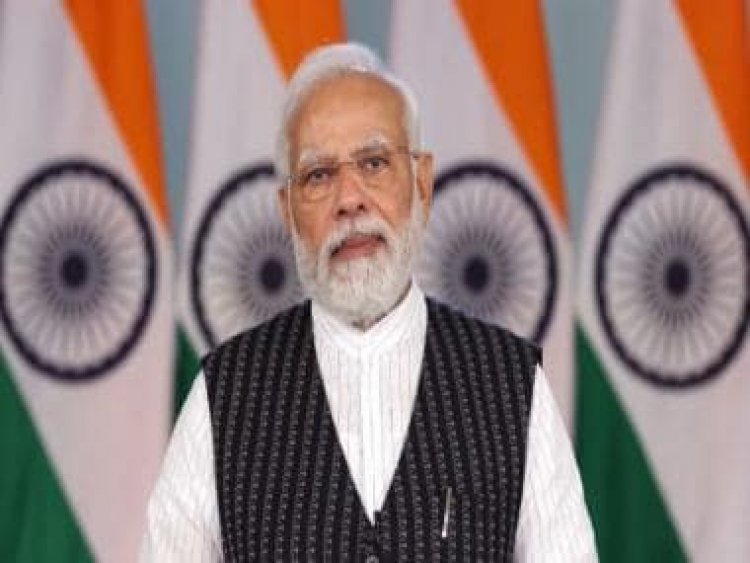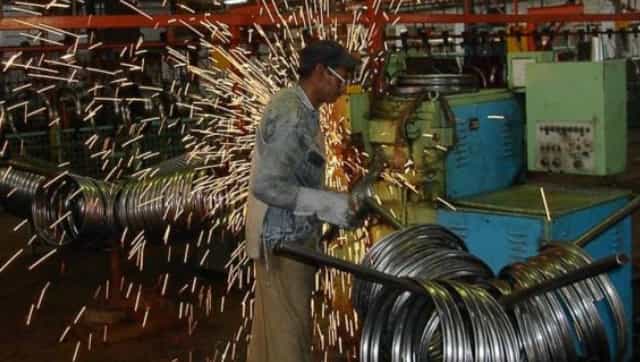Modinomics, 13.5% growth rate, and how India raced past Britain
Modinomics, 13.5% growth rate, and how India raced past Britain

India’s Gross Domestic Product (GDP) grew at 13.5 per cent in the first quarter of 2022-23 (1QFY23), the fastest pace in four quarters, with the Gross Value Added (GVA) too rising by 12.7 per cent. While 13.5 per cent is lower than the 16.2 per cent GDP uptick projected by the Reserve Bank of India’s Monetary Policy Committee (MPC), the best thing about the solid 13.5 per cent growth is that it is a good 3.8 per cent above pre-pandemic levels. This indicates that not only is the Indian economy sharply back on track but has also regained its pre-pandemic mojo. Those claiming that base effect had a role to play, forget that in the June 2021 quarter, the GDP growth was 20.1 per cent. If anything, despite a high base effect, the fact that India still logged 13.5 per cent in the June 2022 quarter, making the GDP number even more commendable.
GVA from agriculture, forestry and fishing continued to grow through the pandemic and rose 4.5 per cent in the June 2022 quarter too, yet again, while manufacturing and mining grew at 4.8 per cent and 6.5 per cent, respectively. While share of government final consumption expenditure (GFCE) in GDP moderated to 11.2 percent from 12.6 per cent last year, GDP growth was boosted by private final consumption expenditure (PFCE), which surged to 59.9 per cent in 1QFY23, from 54 per cent in Q1 of 2021-22 (1QFY22). Gross Fixed Capital Formation (GFCF), which reflects capital investments in the economy, improved to 34.7 per cent in 1QFY23, from 32.8 per cent in 1QFY22. In fact, GFCF and private consumption spending in the first quarter of 2022-23 were at their highest levels in the past 10 years, aided by several reforms and steps taken by the Modi government to reinvigorate capital investments and boost consumption.
Share of imports in GDP has jumped to 31 per cent in 1QFY23, from 25.7 percent in 1QFY22, while the share of exports inched up to 22.9 percent from 22.7 per cent in the said period. This was the highest share for exports in Q1 of any year since 2014-15, despite supply chain disruptions and slowing global demand.
Compared to the pre-pandemic GDP level of Rs 35.5 lakh crore in the first quarter of 2019-20 (1QFY20), real GDP growth is only 3.8 per cent. While that is true, let no one forget that like the rest of the world, India faced two crippling Black Swan events — the Covid-19 pandemic and the Russia-Ukraine war. Both these global events had far-reaching ramifications, disrupting global supply chains, global food production, adversely affecting business confidence and overall global retail sentiment. Yet, despite so many headwinds one after the other, India’s broad-based V-shaped recovery is a testimony to the far-sightedness of Prime Minister Narendra Modi.
With over 213 crore vaccine doses already administered, India has given both doses to its entire eligible adult population. More than 4 crore people in the 12-14 year age group, over 6 crore in the 15-18 year age group and with over 15 crore precaution doses given, Prime Minister Modi turned crisis into an opportunity by undertaking bold reforms. A classic example is the decision to sell Air India, which at the rate of Rs 20 crore worth of losses per day, was in any case, nothing but a white elephant.

Coming back to 1QFY23 GDP growth of 13.5 per cent, public administration, defence and other services which include education, health, recreation, and other personal services, these recorded the sharpest GVA growth at 26.3 per cent, followed by trade, hotels, transport, communication and services related to broadcasting, which grew 25.7 per cent.
The consumption demand revival has been uneven but rural demand is now moving ahead at a sound pace. For example, look at the numbers of M&M. While passenger vehicle sales in August grew by a whopping 77 percent, the commercial vehicle segment also saw a massive growth of 144 percent, YoY. Tractor demand continued to hold steady. Maruti Suzuki reported a year-on-year (YoY) sales growth of 26.4 percent in August 2022, after selling a total of 1.65 lakh units (domestic + exports) this month.
Not only auto sales, even GST collections have been robust, with GST revenues in August 2022 coming in at Rs 1.44 lakh crore, up 28 per cent, YoY, after a record-breaking collection of Rs 1.68 lakh crore in April 2022. There was a generation of 7.6 crore e-way bills in July 2022, which was higher compared to the 7.4 crore in June 2022 and 19 per cent more than 6.4 crore, in June 2021.There are allegations that the 1QFY23 GDP growth has been driven by the Services sector and not Manufacturing. Services as measured by PMI, saw a reading of 59.2 in June 2022, the highest print ever in 11 years.
That said, manufacturing has begun to take-off, with an uptick in the capex cycle, capacity utilisation hitting 75 percent or more across a whole host of industries and sectors. Construction, for example, has seen a massive uptick with a growth of 16.8 percent in the June 2022 quarter, despite a phenomenally high growth of 71.3 per cent in the June 2021 quarter. Ditto goes for the electricity, gas and utilities’ segment which grew by a robust 14.7 per cent in 1QFY23, after an equally impressive 13.8 percent in 1QFY22.
Manufacturing growth came in at 4.8 per cent in 1QFY23, after having contracted by 0.2 per cent in the March 2022 (4QFY22) quarter. The S&P Global India Manufacturing was steady at 56.2 in August 2022, from July’s print of 56.4, beating market consensus of 55, signalling the second-strongest expansion in the manufacturing sector since November 2021. Both output and new orders expanded at the fastest pace since last November and new export orders rose at a faster rate too.

With the eight core industries accounting for 40.3 per cent of the total weight of IIP, IIP growth is in many ways driven by core sector’s growth. For instance, the core sector and IIP growth in April 2022 stood at 8.4 per cent and 7.1 per cent, respectively. That momentum has continued, largely speaking. For instance, while growth of eight core sectors was 4.5 per cent in July 2022, a drop from 9.9 per cent expansion seen in July 2021 and 13.2 per cent YoY growth seen in June 2022, a closer analysis reveals that barring crude oil output and natural gas production, some of the core sector components rose handsomely in July 2022, with coal production up 11.4 per cent, steel up 5.7 per cent and fertiliser output up 6.2 per cent YoY. Going back to the June 2022 quarter number (1QFY23), the best part of the 13.5 per cent GDP growth is that it is all pervasive. Industry grew by 8.6 per cent, services by 17.6 per cent, trade and hotels rose a massive 25.7 per cent, construction by a healthy 16.8 per cent, power & gas by a good 14.7 per cent, and finance & real estate by 9.2 per cent.
The GVA growth for mining and quarrying was only 6.5 per cent, seemingly reflecting the impact of the high global commodity prices over the last few months. But now that global commodity prices including crude oil prices have started tapering off significantly, positive surprises on the mining front can be expected going forward. The 25.7 per cent rise in contact sensitive sectors like trade and hotels in 1QFY23, after a tepid 5.3 per cent growth in 4QFY22, is by far the clearest example of how India’s quick paced vaccination drive, prolonged low interest rates and a targeted approach to fiscal stimulus by the Modi government, have worked wonders.
Again, note, this 25.7 per cent growth came about despite a very high base in June 2021 quarter when the growth in this segment was 34.3 per cent. Finance, real estate and professional services which rose by only a meagre 2.3 per cent in the June 2021 quarter, inched up to a rise of 4.3 per cent in the March 2022 quarter, before registering a very healthy 9.2 per cent jump in the June 2022 quarter, in sync with the rise in credit growth of 14 per cent YoY, in recent times.
Repeatedly, the June 2022 quarter has shown solid growth on various counts despite the Indian economy having the disadvantage of a high base effect, so critics and an ill-informed Opposition that have been quick to dismiss these June 2022 quarterly numbers, should get a reality check. We have done well despite a high base effect and not the way around!
Naysayers claim that even if the RBI’s forecasts for the subsequent three-quarters of FY23 are met, the Central bank’s full-year forecast of 7.2 per cent will be missed by more than 20 basis points. Well, there is every reason to believe that RBI’s projections for next three quarters may actually be surpassed.
Inflation which was 7.79 per cent in April 2022 is already down to 6.71 per cent in July 2022. Food inflation too is down from 8.38 per cent to 6.75 per cent in this period. It is pertinent to note here that for 23 months till July 2022, cereal inflation consistently stayed below 6 per cent in India, while the rest of the world saw wheat and rice prices rising by over 40 percent in just the last 2 years, in large parts of the globe.
Given declining inflation, the pressure on RBI to raise rates on 30 September, 2022, will be much lower and instead of a 50bps Repo rate hike, RBI may end up with a 25-35bps rate hike.
While rate hikes, once they start, are normally front loaded, given that growth has picked up significantly and inflation has started declining meaningfully, India delivering a GDP growth rate exceeding RBI’s own estimate of 7.2 percent in FY23, may well be on the cards. And that says volumes about India, which at 8.7 per cent was the fastest growing global economy last year and is poised for a repeat this year too. That India at $3.5 trillion overtook the UK at $3.2 trillion, to become world’s fifth largest economy, is an endorsement of how PM Modi deftly steered India amidst multipronged challenges in the last few years, without ever losing focus of reforms, financial stability and welfarism.
Remember, India is already the world’s third largest economy in PPP terms, with a size exceeding $11 trillion. Seeing the accelerated growth path taken by India since 2014 under Prime Minister Modi, India is likely to get the tag of the world’s third largest economy in terms of nominal GDP too, by 2029, seven ranks higher since 2013, when the country was ranked tenth. India should surpass Germany in 2027 and most likely Japan by 2029 at the current rate of growth, a remarkable achievement by any standards, as per experts.
The author is an economist, national spokesperson of the BJP and the author of ‘The Modi Gambit’. Views expressed are personal.
Read all the Latest News, Trending News, Cricket News, Bollywood News,
India News and Entertainment News here. Follow us on Facebook, Twitter and Instagram.
What's Your Reaction?



























































